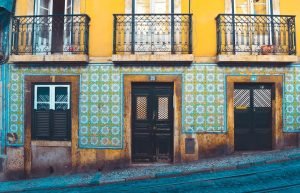
Das F1-Erbe von Portimao
Portimao, eine Küstenstadt in der portugiesischen Algarve-Region, hat sich in den letzten Jahren zu einem wichtigen Ziel für Formel-1-Rennen entwickelt. Diese Entwicklung ist auf mehrere Faktoren zurückzuführen
Portugal’s public transport system is an efficient and convenient way to explore the country. With a variety of modes of transportation available, including metro, tram, bus, train, funiculars, and ferries, travelers have plenty of options to choose from. Understanding how the system works is essential for a smooth and enjoyable journey.
For travelers visiting Portugal, understanding the public transport system is crucial. It allows you to navigate the cities and towns easily, reach popular tourist attractions, and experience the local culture. By using public transport, you can save money on transportation costs and reduce your carbon footprint. This beginner’s guide will provide you with all the information you need to know about Portugal’s public transport system.
Portugal’s public transport system consists of various modes of transportation, including metro, tram, bus, train, funiculars, and ferries. Each mode has its own ticketing system and routes, so it’s important to familiarize yourself with the options available.
The ticketing system in Portugal is relatively straightforward. In most cases, you can purchase tickets at ticket machines located at the stations or on board the vehicles. Some cities also offer reloadable cards that can be used for multiple journeys. It’s important to validate your ticket before boarding to avoid any fines.
When planning your journey, it’s helpful to use online resources such as official transport websites or mobile apps that provide real-time information on routes, schedules, and fares. This will help you plan your itinerary more efficiently and avoid any unnecessary delays.
Lisbon’s metro system is one of the most efficient ways to get around the city. It consists of four lines that cover the main areas of Lisbon and connect to major transportation hubs such as airports and train stations.
To use the metro, you can purchase single tickets or rechargeable cards at the ticket machines located at the stations. The metro operates from 6:30 am to 1:00 am, with trains running every few minutes during peak hours and every 10-15 minutes during off-peak hours.
When using the metro, it’s important to keep in mind that some stations have multiple exits, so make sure to follow the signs to the correct exit. Also, be aware of your surroundings and keep an eye on your belongings, as pickpocketing can be an issue in crowded areas.
Porto’s tram system is a charming and nostalgic way to explore the city. The trams, known as “elétricos,” run on three different routes and pass by some of Porto’s most iconic landmarks.
To ride the tram, you can purchase tickets on board or at ticket machines located at tram stops. The trams operate from early morning until late at night, with a frequency of around 15-20 minutes during peak hours and 30 minutes during off-peak hours.
When using the tram, it’s important to be aware of your surroundings and hold on to your belongings, as pickpocketing can be an issue in crowded trams. Also, keep in mind that the trams can get quite crowded during peak hours, so it’s best to avoid traveling during those times if possible.
Portugal’s bus system is an extensive network that connects cities, towns, and villages across the country. It’s a convenient way to reach destinations that are not served by other modes of transportation.
To use the bus system, you can purchase tickets on board or at ticket offices located at bus stations. Some cities also offer reloadable cards that can be used for multiple journeys. The bus schedules and routes can vary depending on the city or region, so it’s important to check the timetables in advance.
When using the bus, it’s important to be at the bus stop a few minutes before the scheduled departure time, as buses can sometimes arrive early. Also, make sure to have the correct change or a reloadable card, as drivers may not always have change available.
Portugal’s rail network is an efficient and comfortable way to travel between cities and regions. The trains are modern and well-maintained, offering scenic views of the countryside along the way.
To use the train system, you can purchase tickets at ticket offices located at train stations or online through the official train company’s website. Some cities also offer reloadable cards that can be used for multiple journeys. It’s important to validate your ticket before boarding to avoid any fines.
When using the train, it’s important to be at the station a few minutes before the scheduled departure time, as trains can sometimes leave early. Also, keep in mind that some trains require seat reservations, so it’s best to check in advance if a reservation is required for your journey.
To save money on public transport tickets in Portugal, there are a few insider tips you can follow. First, consider purchasing reloadable cards if you plan on using public transport frequently. These cards often offer discounted fares and can be more convenient than purchasing single tickets.
Another tip is to take advantage of any available discounts or special offers. For example, some cities offer discounted fares for students, seniors, or residents. It’s worth checking if you qualify for any of these discounts before purchasing your tickets.
When it comes to buying tickets, it’s best to purchase them in advance whenever possible. This will not only save you time but also ensure that you have a ticket for your desired journey, especially during peak travel seasons.
Portugal’s hillside cities, such as Lisbon and Porto, are known for their steep streets and hills. To make it easier for residents and visitors to navigate these cities, funiculars and elevators are available.
Funiculars are cable-operated railways that transport passengers up and down steep slopes. They are a convenient way to reach higher parts of the city without having to climb stairs or walk uphill. Elevators, on the other hand, are vertical lifts that connect different levels of the city.
When using funiculars and elevators, it’s important to follow any safety instructions provided and be mindful of other passengers. Also, keep in mind that these modes of transportation can get crowded during peak hours, so it’s best to plan your journey accordingly.
Portugal is home to several beautiful islands, including Madeira and the Azores. To reach these islands, ferries and boat tours are available.
Ferries operate regular services between the mainland and the islands, offering a convenient way to travel. It’s important to check the schedules in advance, as they can vary depending on the season.
Boat tours are also a popular way to explore the islands and their surrounding waters. These tours offer a unique perspective of the islands’ landscapes and wildlife. It’s best to book boat tours in advance, especially during peak travel seasons.
Portugal’s public transport system is designed to be accessible for travelers with disabilities or special needs. Many buses, trams, trains, and metro stations are equipped with ramps or elevators to accommodate wheelchair users.
It’s important to check the accessibility options available for each mode of transportation before planning your journey. Some cities also offer special services for travelers with disabilities, such as dedicated assistance or priority seating.
When using public transport, it’s best to inform the transport staff of any special needs or requirements you may have. They will be able to provide you with the necessary assistance and ensure a smooth journey.
Portugal is committed to sustainable travel and offers several eco-friendly transport options. These include electric buses, bike-sharing programs, and car-sharing services.
To reduce your carbon footprint while traveling in Portugal, consider using these eco-friendly transport options whenever possible. For short distances, walking or cycling is a great way to explore the cities and towns. If you need to travel longer distances, consider using public transport or car-sharing services instead of renting a car.
Portugal is also investing in renewable energy sources and promoting sustainable tourism practices. By choosing eco-friendly transport options and supporting sustainable initiatives, you can contribute to the preservation of Portugal’s natural beauty and cultural heritage.
Understanding Portugal’s public transport system is essential for travelers looking to explore the country efficiently and responsibly. With a variety of modes of transportation available, including metro, tram, bus, train, funiculars, and ferries, there are plenty of options to choose from.
By familiarizing yourself with the ticketing system, routes, and schedules, you can plan your journey more efficiently and save money on transportation costs. It’s also important to consider sustainable travel options and reduce your carbon footprint while exploring Portugal.
Whether you’re navigating Lisbon’s metro, riding the tram in Porto, or exploring Portugal’s islands, using public transport is a convenient and eco-friendly way to experience the country’s rich culture and natural beauty. So hop on a bus, train, or ferry, and start your adventure in Portugal.
If you’re planning a trip to Portugal and need some tips on navigating public transport, be sure to check out this helpful article: Ultimate Guide to Lagos, Portugal. It provides valuable information on how to get around the city using buses, trains, and trams, as well as tips for purchasing tickets and understanding the public transport system. Whether you’re exploring the beautiful beaches or visiting historical sites, this guide will ensure you have a smooth and hassle-free experience getting around Lagos.

Portimao, eine Küstenstadt in der portugiesischen Algarve-Region, hat sich in den letzten Jahren zu einem wichtigen Ziel für Formel-1-Rennen entwickelt. Diese Entwicklung ist auf mehrere Faktoren zurückzuführen

Die Algarve-Region in Portugal ist für ihre vielfältigen Attraktionen bekannt, zu denen neben den berühmten Stränden und malerischen Landschaften auch eine florierende Weinindustrie gehört. Die Region ist

Das öffentliche Verkehrssystem Portugals ist eine effiziente und bequeme Art, das Land zu erkunden. Es gibt eine Vielzahl von Verkehrsmitteln, darunter Metro, Straßenbahn,